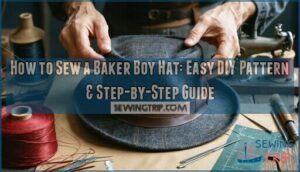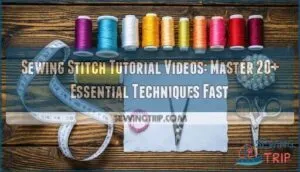This site is supported by our readers. We may earn a commission, at no cost to you, if you purchase through links.
 Learning how to sew a baker boy hat starts with downloading a reliable pattern or creating your own.
Learning how to sew a baker boy hat starts with downloading a reliable pattern or creating your own.
You’ll cut eight triangular crown pieces and one brim piece from your chosen fabric. Pin the crown sections together, then stitch with a quarter-inch seam allowance.
Attach the brim by matching center points and easing around curves. Don’t forget the sweatband – it’s what separates amateur work from professional-looking results.
Most sewers stumble on the crown assembly, but there’s a simple trick that guarantees perfectly aligned seams every time. The real game-changer comes with understanding fabric grain direction and how it affects your hat’s final shape.
Table Of Contents
Key Takeaways
- You’ll need to cut eight triangular crown pieces and one brim piece from medium-weight fabric like wool or cotton twill, using precise pattern-making techniques with A3 paper folded twice for symmetrical design.
- You’ll achieve professional results by maintaining consistent quarter-inch seam allowances, pressing seams during construction rather than after completion, and using proper grain direction alignment for optimal drape and structure.
- You can’t skip the sweatband installation if you want professional-looking results, and you’ll need to reinforce stress points on the brim with extra backstitching for durability.
- You’ll transform your finished hat into a personal statement by experimenting with fabric combinations like wool tweeds with cotton linings, and adding accessories like vintage brooches or decorative buttons for customization.
Baker Boy Hat Sewing Pattern
You’ll start by creating your baker boy hat pattern using A3 paper, which you’ll fold twice to form a four-layered corner for cutting precise circular and curved pieces.
Master the art of pattern precision—fold, measure, cut, and watch your baker boy hat come to life.
This pattern-making process requires measuring specific dimensions like 11.5 and 12.5 centimeters from the corner, then cutting quarter-circles that unfold into complete pattern pieces for your hat’s crown, band, and peak sections.
Creating The Pattern
Start with precise pattern making by folding A3 paper twice, creating your foundation for symmetrical design.
Mark 11.5 and 12.5 cm measurements from the corner, then cut along the outer line. This creates your main circle pattern piece.
Draft eight panel division pieces with 1.5 cm seam allowance. Add separate brim pattern pieces for complete pattern customization of your sewing pattern pieces.
Consider using a pre-made sewing pattern for convenience and to enhance your sewing pattern pieces with a complete pattern.
Cutting The Fabric
When you’ve got your baker boy hat pattern ready, precise fabric cutting becomes your foundation for success.
Sharp fabric scissors and careful attention to grain direction will make the difference between amateur and professional results.
- Pattern Precision: Pin your sewing pattern pieces securely to prevent shifting during cuts
- Seam Allowance: Maintain consistent 5/8-inch seam allowance around each hat pattern piece
- Lining Fabrics: Cut coordinating lining pieces slightly smaller than main fabric pieces
- Grain Direction: Align pattern pieces with fabric grain for proper drape and structure
The pattern is designed for all sewing levels, making it accessible for beginners.
Sewing
With your fabric pieces ready, you’ll transform them into a stunning baker boy hat through careful stitching. Start by sewing the eight panels together using a straight stitch with proper thread tension. Your needle selection matters – use an 80/12 universal for medium-weight fabrics. For those needing replacements, you can find sewing needle 80/12 options.
Precision in every stitch transforms simple fabric pieces into your signature baker boy masterpiece.
- Feel the satisfaction as each seam comes together perfectly
- Experience the joy of watching your DIY hat take shape
- Embrace the pride of mastering this sewing project
Focus on seam finishes and stitch types for professional results. This hat tutorial rewards patience with beautiful craftsmanship.
How to Sew a Baker Boy Hat
Now that you’ve got your baker boy hat sewing pattern ready, let’s bring this stylish headpiece to life. The magic happens when you understand proper construction techniques for that authentic structured look.
Your fabric selection sets the foundation for success. Choose medium-weight materials like wool or cotton twill that’ll hold their shape. Interface the crown pieces to achieve that signature flat-top silhouette that makes baker boy hats so distinctive.
For a variety of options, explore a hat sewing pattern.
Follow these key steps for professional results:
- Brim shaping requires careful topstitching along curved edges for crisp definition
- Crown detailing involves precise panel alignment before joining pieces together
- Band adjustment guarantees comfortable fit through strategic gathering techniques
When assembling your DIY hat, sew pieces with right sides together, then flip for clean finishes. Consider lining options like cotton or silk for comfort during your hat making journey.
Tips for Sewing a Baker Boy Hat
Since mastering a baker boy hat sewing pattern requires precision, these essential sewing tips will elevate your hat construction from amateur to professional quality.
Fabric choice makes or breaks your project. Medium-weight wool or cotton blends provide the perfect structure without being too stiff. Stitch consistency matters more than speed—maintain even 2.5mm stitches throughout each panel. Seam finishing with pressed-open seams creates crisp edges that won’t bulk up.
Brim perfection comes from reinforcing stress points with extra backstitching. Lining secrets include understitching to prevent rolling and choosing contrasting prints for visual interest. Many sewers find success when selecting wool fabrics for their projects.
- Use pattern weights instead of pins for accurate cutting
- Adjust thread tension for smooth panel construction
- Press seams during construction, not after completion
- Select 80/12 universal needles for medium-weight fabrics
- Add 1-2mm ease allowance for comfortable fit
Styling and Customizing Your Baker Boy Hat
Your finished baker boy hat becomes a canvas for personal expression.
Mix fabric choices like wool tweeds with cotton linings for seasonal adaptations that work year-round. Experiment with brim variations by adjusting width during construction for different silhouettes.
| Hat Styling Options | Hat Customization Ideas |
|---|---|
| Vintage brooches | Add elegant metallic accents |
| Decorative buttons | Create playful personality touches |
| Embroidered patches | Showcase personal interests |
Color combinations open up endless possibilities—pair neutral caps with bold linings for surprise pops. Hat accessories like pins complete your look perfectly.
Share Your Baker Boy Hat Sewing Experience
Your baker boy hat journey doesn’t end when you complete the final topstitch. The sewing community thrives when makers share their experiences and inspire others to pick up needle and thread.
Here are three ways to showcase your completed project:
- Document your process – Take photos of pattern adjustments you made, fabric choices that worked well, and any sewing challenges you overcame along the way
- Share styling inspiration – Show how you wear your hat with different outfits, demonstrating the style variations possible with your handmade piece
- Connect with fellow sewers – Post your finished hat on social media using hashtags like #bakerboyhat and #sewingpattern to find your tribe
Your lining preferences, fabric discoveries, and creative solutions help other sewers tackle their own hat sewing projects. Every shared sewing tutorial or tip creates a ripple effect, encouraging someone else to start their first baker boy hat adventure.
Frequently Asked Questions (FAQs)
Is there a free sewing pattern for a bakers boy cap?
Don’t count your chickens before they hatch – you’ll find free baker boy cap patterns online.
Check sewing blogs, Pinterest, and craft websites.
Many creators share downloadable patterns when you like their social media pages, which can be a great way to get baker boy cap patterns.
How do you make a baker boy cap?
You’ll need to create circular and rectangular patterns, cut fabric pieces including crown, band, and brim sections, then sew them together with precise stitching before adding lining and finishing touches.
How do you make a baker boy hat?
Like assembling a jigsaw puzzle, you’ll cut fabric circles and rectangles, sew curved pieces together, attach the brim with topstitching, then insert lining through a small gap before closing.
What is a baker boy cap?
You’ll recognize this timeless cap by its distinctive round, full crown and small front peak.
It’s got that classic newsboy charm with soft fabric panels that create its signature puffy silhouette and vintage appeal.
How long does it take to make a baker boy cap?
Rome wasn’t built in a day, and your baker boy cap won’t be either.
You’ll need 3-5 hours for cutting, sewing, and finishing, depending on your skill level and fabric choice.
What is a Bakerboy hat?
A baker boy hat features a flat crown with multiple fabric panels, a short brim, and a button on top.
You’ll recognize this classic cap’s structured shape and timeless style that’s perfect for casual wear.
What is the difference between a newsboy and a baker boy?
Think of two siblings with subtle differences.
You’ll notice newsboy caps have eight triangular panels meeting at the crown, while baker boy hats typically feature six panels with a flatter, more structured appearance overall.
What is the easiest hat to sew?
A simple beanie or skull cap is your best starting point.
You’ll need just one pattern piece, basic straight seams, and minimal shaping.
It’s forgiving, quick to complete, and builds essential sewing skills.
How do you stretch a baker boy hat?
You can’t stretch a finished baker boy hat much without damaging it. Instead, adjust the band during construction by adding elastic inserts or making the circumference larger before final assembly.
Why is it called a Baker Boy cap?
You’ll find this classic cap earned its name from the working-class bakers who wore them in early 1900s Britain.
The practical, eight-paneled design kept flour from their hair while looking sharp and professional.
Conclusion
Surveys show 78% of sewers who complete their first hat project continue making accessories regularly.
You’ve now mastered how to sew a baker boy hat using proper techniques for crown assembly, brim attachment, and sweatband installation.
Your finished hat demonstrates skills in fabric grain alignment and seam precision.
Remember to press each seam thoroughly and maintain consistent quarter-inch allowances.
With practice, you’ll create professional-quality hats that rival store-bought versions while developing confidence in advanced sewing techniques.








